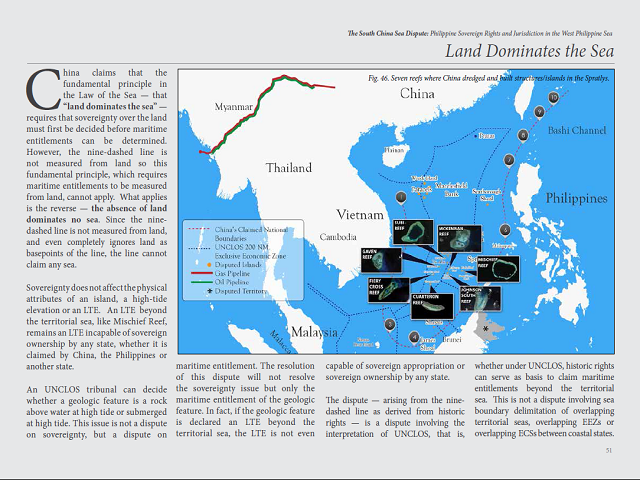Calling Out the Failure to Respond to Chinese Bombers in the South China Sea

Screengrab from Philippine Sovereign Rights and Jurisdiction in the West Philippine Sea by Senior Associate Justice Antonio T. Carpio.
SILENCE CAN be louder than sound itself.
On May 18, Chinese strategic bombers, including the top-of-the-line H-6K, had been reported to conduct take-off and landing exercises on Woody Island, China’s largest base in the Paracel island chain in the South China Sea. This development comes two weeks after the deployment of Chinese missile systems in three reefs in the Spratlys, parts of which are inside the Philippines’ exclusive economic zone.
Is there a cause for concern? News accounts quoted the Asia Maritime Transparency Initiative’s report also released on May 18: “The base H-6 aircraft’s combat radius of nearly 1000 nautical miles means even China’s basic bombers taking off from Woody Island could cover the entire South China Sea. Nearly all of the Philippines falls within the radius of the bombers, including Manila and all five Philippine military bases earmarked for development under the US-Philippines Enhanced Defense Cooperation Agreement. An H-6K, with its technical upgrades giving it a combat radius of nearly 1900 nautical miles, would dwarf this radius, putting all of Southeast Asia in range of flights from Woody Island.”
This kind of information cannot be ignored. But silence or failure to respond describes exactly the Philippine government’s conciliatory stance on China’s militarization of the area.
The silence was loud and clear enough to provoke media to point out.
Rappler reported that “despite the barrage of questions” on the Department of Foreign Affairs’ (DFA) Viber group, the DFA “stayed silent” on the landing of the Chinese bombers.
Rappler said the reporters’ questions were still unanswered on Sunday, May 20, two days after the report came out. At about the same time, the department issued statements in response to the Texas school shooting and the meeting between Philippine officials and retiring US Pacific Command Chief Harry Harris, Jr. Statements on both events were issued on May 19 and 20 (“DFA silent on Chinese bombers in South China Sea“).
Malaya reported that it was not only the DFA which failed to respond; the Department of National Defense and the Armed Forces of the Philippines remained quiet as well (“Gov’t agencies remain mum on Chinese bombers“). In a separate report, Malaya recalled an earlier instance of silence: “Duterte has not called out Beijing over the deployment of missile systems in the Fiery Cross Reef, Subi Reef and Mischief Reef which fall within the country’s exclusive economic zone and instead put blame on his predecessor, Benigno Aquino III, and the US for their alleged failure to stop China’s moves in the area (“DFA on China issue: Not every move can be made public“).”
DFA eventually released a statement on May 21, saying it is “closely monitoring developments in the West Philippine Sea and the South China Sea.” The DFA also claimed that they are taking the “appropriate diplomatic action necessary” to protect the country’s claims.
The Philippine Daily Inquirer and Philstar.com did not let the statement go uncriticized. Inquirer said, “Foreign Secretary Alan Peter Cayetano has refused to state publicly what the DFA is doing to defend Philippine sovereignty in the strategic waterway and instead has insisted that the Duterte administration’s tack in dealing with the territorial dispute with China has resulted in economic gains for the Philippines (“Palace concerned but not threatened by Beijing’s aggressive actions“).”
On the repeated claim about “diplomatic actions”, Philstar.com said, “The Philippines, however, has not publicly expressed condemnation nor concern toward China’s behavior in the contested waterway (“Philippines refuses to call out China amid bomber in South China Sea“).”
Better late than never. Media was pretty silent when the photographic evidence of China’s military build-up first broke into the news. Media’s reports give voice to the questions many Filipinos are asking. What options are open to the Duterte government after it had sworn its abiding affinity with China and the president’s declaration of love for Xi Jinping?
Filipinos understand that we do not have the capacity to fight back. But is war the only option? Is there no range of response to be explored apart from this abject surrender to China’s wishes?
If the media examines this more closely, it should be able to make the point that Filipinos deserve an answer from their government.
Leave a Reply